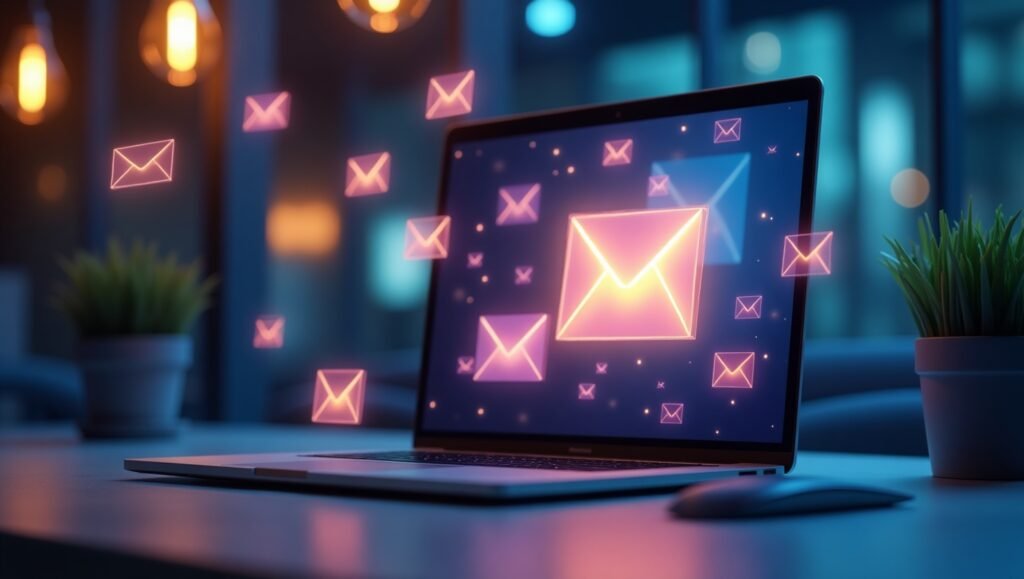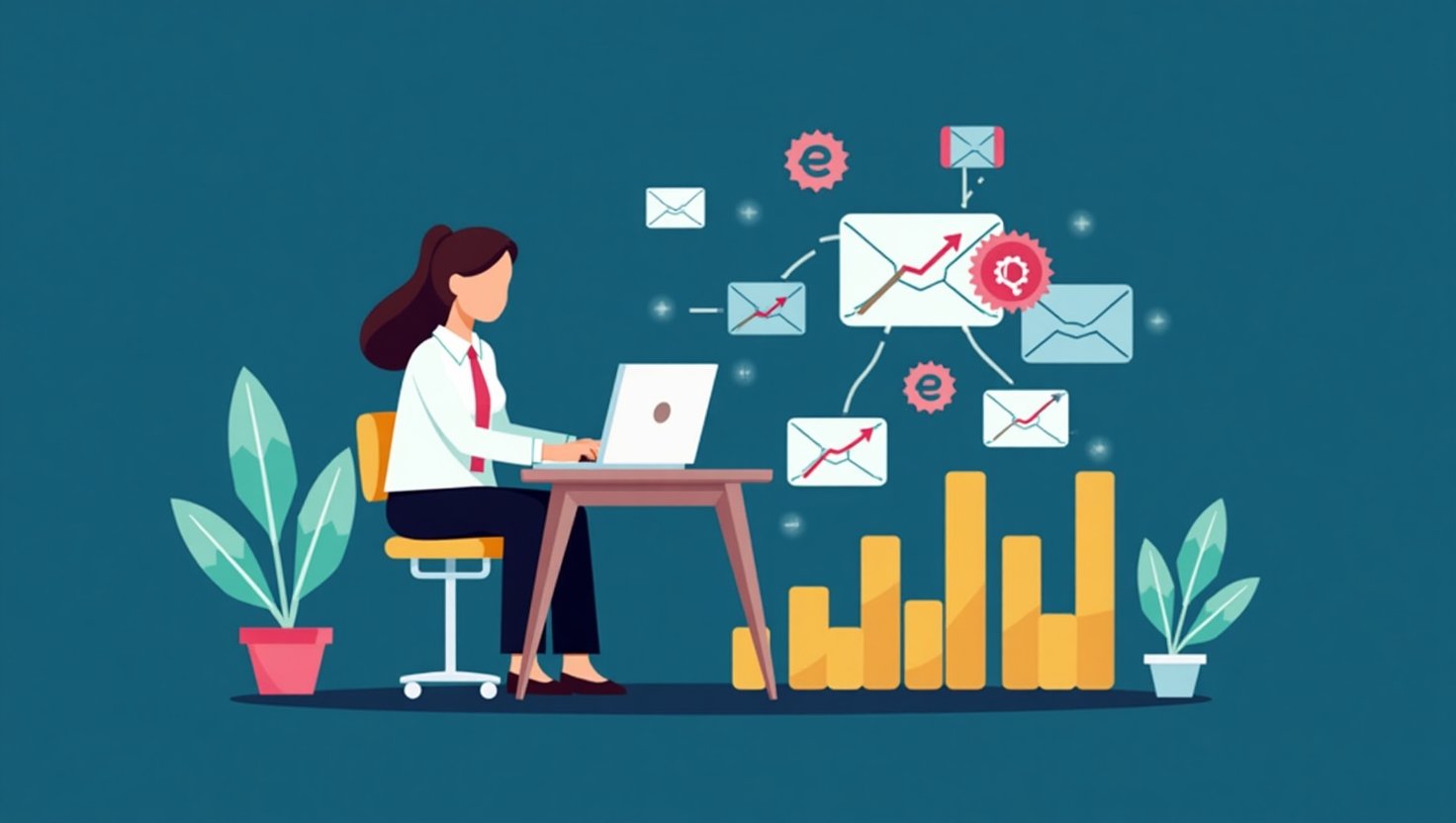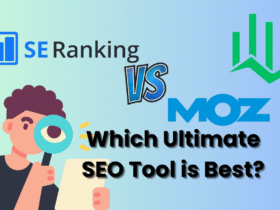How to Make B2B Email Marketing-B2B email marketing is a powerful tool for businesses. It helps companies connect with other businesses, generate leads, and increase sales. Email marketing can bring in a lot of money if done right. It also helps you build strong, lasting connections with customers.
In this guide, we will explain B2B email marketing in simple words. We will also share the best practices to make your email campaigns successful.
What is B2B Email Marketing?
B2B email marketing is when one business sends an email to another business. The email tells them about what they sell or offer. These emails are not for individual customers but for key decision-makers in companies.
A good B2B email should:
- Have a clear reason for sending it
- Talk directly to the reader
- Give a real solution to a business problem
Most businesses use email marketing to:
- Generate leads (find new customers)
- Nurture relationships (keep in touch with potential buyers)
- Increase sales (turn leads into customers)
Email marketing is different from social media marketing because it creates direct communication. The message goes directly to the inbox of the people who make decisions, making it more effective.
B2B vs B2C Email Marketing
B2B and B2C (Business-to-Consumer) email marketing are different.
B2C Emails
Fun and engaging
Professional and informative
Short and emotional
Data-driven and logical
Discounts and offers
Value-based solutions
Urgent “Buy Now” messages
Focus on long-term benefits
In B2B email marketing, buyers take time to decide. They compare options, check the ROI, ad discuss with their teams before making a purchase. That is why B2B emails should be well-planned and detailed.
Why is B2B Email Marketing Important?
Email marketing is one of the best ways to connect with businesses. Here are some reasons why:
High ROI – For every $1 spent on email marketing, businesses can earn up to $38 in return.
Direct Communication – Unlike social media, emails land directly in the inbox.
Better Targeting – Emails can be personalized for different business needs.
Easy to automate. Businesses can set up automatic emails to contact customers at the right time.
Great for keeping leads engaged. Businesses can teach potential customers and earn their trust over time.
9 Best Practices for B2B Email Marketing
To make email marketing work for your business, follow these 9 best practices.
1. Define Your Goals
Before sending emails, decide what you want to achieve. Common goals include:
Getting new possible buyers. Turning them into customers. Making more people know about your business. Keeping in touch with old customers.
Each goal needs a different email strategy. If you want to get leads, give something useful, like a free eBook or webinar.
2. Segment Your Audience
Not all businesses are the same. To send the right message to the right people, divide your audience into different groups.
Ways to segment your audience:
Industry – Tech companies need different emails than retail businesses.
Company size – A small startup and a large enterprise have different needs.
Role in the company – CEOs, marketers, and HR managers have different interests.
Buying stage – New leads need more education, while ready-to-buy customers need an offer.
By segmenting your audience, you can send emails that are relevant and useful.
3. Have a Clear Message
Busy professionals don’t have time to read long emails. Keep your message clear and to the point.
A good email should start with a catchy subject line. It should quickly show why it’s useful, use easy words, and end with a clear action step.
“AI-driven insights in our solutions are revolutionizing the industry.” Good email: “Need better business solutions? Try our AI tool for free!”
Simple and clear messages work best.
4. Personalize Your Emails
Personalization makes emails feel special. Instead of sending the same email to everyone, make it personal and relevant.
Use the person’s name. Mention their company or industry. Talk about their problems. Share content they would like.
Example of a personalized email:
Hi [Name],
I noticed your company [Company Name] is growing fast. Many companies in your industry use [Your Product] to manage [specific business challenge].
Would you be open to a quick call to see how we can help?
Best, [Your Name]
This kind of email feels more friendly and personal, making it more likely to get a reply.
5. Make Your Call-to-Action (CTA) Obvious
A CTA tells the reader what to do next. Every email should have one clear CTA.
Examples of strong CTAs:
- “Download the free guide”
- “Book a demo”
- “Start your free trial”
- “Get a custom quote”
Keep the CTA simple and visible. One email, one action.
6. Send Emails at the Right Time
Timing is important. If you send an email when people are busy, they may ignore it.
The best days to send emails are Tuesday, Wednesday, and Thursday. These days have the highest open rates. Morning (8 AM – 10 AM) or Afternoon (2 PM – 4 PM) – Professionals check emails during these hours.
Avoid Mondays (too busy) and Fridays (people are thinking about the weekend).
7. Ensure Your Emails Are Delivered
If your emails go to spam, no one will read them. To improve deliverability:
Use a work email address (not Gmail or Yahoo). Don’t use words like “free money” or “guaranteed.” Keep your email list updated by removing people who aren’t active. Ask subscribers to add your email to their safe list.
These steps will increase the chances of your emails reaching the inbox.
8. Organize Follow-Ups
Most people don’t reply to the first email. That’s why follow-ups are important.
Here are some tips for a follow-up email: Wait 2-3 days before sending a reminder. Change the subject line to grab attention. Keep the email short and polite.
Example follow-up email:
Subject: Quick follow-up on my last email
Hi [Name],
I wanted to follow up to see if you had any thoughts on my last email. Let me know if you’re interested, and I’d be happy to set up a quick call.
Best, [Your Name]
Follow-ups increase response rates and keep conversations going.
9. Track Your Email Performance
To improve your emails, you need to track results.
Important email metrics:
- Open Rate – How many people opened your email
- Click Rate – How many people clicked on links
- Reply Rate – How many people responded
- Conversion Rate – How many people took action
If your open rates are low, try a better subject line. If click rates are low, improve your CTA.
FinalThoughts
B2B email marketing is a powerful way to grow your business. By using these simple tips, you can make email campaigns that bring in leads and boost sales.
Set your goals. Divide your audience into groups. Write clear and personal messages. Send emails at the best time. Monitor your results.
Start applying these tips today and watch your B2B email marketing success grow!
Advanced Strategies for B2B Email Marketing
Now that you know the basics, let’s explore advanced ways to improve your B2B email marketing. These tips will help you get better results and more conversions.
10. Use Automation to Save Time
Email automation helps businesses send the right message. It does this at the right time, without needing to do it by hand.It allows you to:
Welcome new subscribers automatically. Send follow-up messages without missing any. Share content based on what users do. Take care of leads until they’re ready to buy.
Example: Automated Email Sequence for New Leads
1.Welcome Email – Thank them for subscribing and introduce your company.
2.Follow-Up Email (Day 3) – Share valuable content like a case study.
3.Problem-Solution Email (Day 7) – Address their pain points and offer a solution.
4.CTA Email (Day 10) – Encourage them to book a demo or start a free trial.
Setting up an automated email sequence ensures consistent communication with leads and customers.
11. A/B Test Your Emails
A/B testing (also called split testing) helps you find out what works best. It involves sending two versions of an email to small groups and comparing the results.
What you can A/B test: Subject lines – Which one gets more opens? Here’s the sentence split into two:
CTA buttons: ‘Book a demo’ or ‘Start your free trial’. Emails: Short or long, and sent in the morning or afternoon.
Testing and improving your emails can help you get more people to interact and take action over time.
12. Write Attention-Grabbing Subject Lines
Your subject line is the first thing people see. If it’s not interesting, your email may not get opened.
Keep it brief (under 50 characters). Use the person’s name. Spark curiosity (ask a question or hint at the content). Avoid spam words (like “free,” “guaranteed,” or “urgent”).
Examples of effective subject lines: “[First Name], struggling with [problem]?” “A quick idea to improve [business area]” “Case study: How [Company Name] doubled their sales”
A strong subject line increases open rates, making your email marketing more effective.
13. Create Engaging Email Content

Once your email is opened, the content must keep the reader’s attention.
Testing and improving your emails can help you get more people to interact and take action over time.
Show how your product or service helps right away. Use pictures or videos to make it more fun. Finish with a clear action, telling them what to do next.
Example of a simple, engaging email:
Subject: Improve your sales process in 5 minutes
Hi [First Name],
Many businesses struggle with [pain point]. That’s why we created [solution] to help companies like yours.
In just 5 minutes, you’ll see how [benefit] works. Click below to watch a short demo:
[Watch the Demo]
Let me know if you have any questions!
Best, [Your Name]
Emails that are short, direct, and valuable get better responses.
14. Leverage Social Proof
Social proof builds trust and makes your emails more convincing. This can include:
Customer testimonials – “This tool helped us increase sales by 50%!” Case studies share real success stories. Client logos show the famous companies you work with. Statistics use numbers to show your impact.
Example of social proof in an email:
“Join 10,000+ businesses using [Your Product] to grow faster.”
Adding proof reduces skepticism and makes people more likely to take action.
15. Use Interactive Elements
Interactive emails increase engagement and keep readers interested. Try using:
Polls and surveys ask for opinions. GIFs and animations make emails more fun. Countdown timers create excitement for special deals. Interactive buttons let readers take action right away.
Adding these elements makes your emails stand out and encourages more clicks.
16. Retarget Inactive Subscribers
Not everyone will respond to your emails. Some leads may lose interest over time. Instead of ignoring them, use retargeting strategies to bring them back.
How to re-engage inactive subscribers:
Send a reminder email – “We haven’t heard from you in a while.” Give something new – like a special discount or unique content. Ask for feedback – “What kind of content do you want to see?”?” Give them an easy opt-out – If they don’t want your emails, let them unsubscribe easily
Cleaning your email list regularly helps your emails reach people. Keeping it active also keeps your audience interested.
17. Optimize for Mobile Users
More than 50% of emails are opened on mobile devices. If your email isn’t mobile-friendly, people will delete it.
How to make your site better for mobile: Use short subject lines (mobile screens cut them off). Keep paragraphs short so they’re easy to read. Use one column layout (don’t put things side by side). Make buttons big and easy to click
By designing emails for mobile-first, you ensure they look good on any device.
18. Track Key Email Metrics
To improve your email marketing, analyze your results. The most important email metrics include:
Here’s a clearer version with two sentences:
The open rate tells you how many people opened your email. The click-through rate (CTR) shows how many people clicked a link inside. The reply rate shows how many people answered. The reply rate shows how many people answered.
The bounce rate shows how many emails didn’t go through. The unsubscribe rate shows how many people stopped getting your emails.
If your open rate is low, improve your subject lines. If CTR is low, improve your CTA. Tracking data helps you adjust and improve your strategy.
19. Follow Legal Guidelines
B2B email marketing must follow email regulations to avoid spam complaints.
GDPR requires consent. CAN-SPAM needs an unsubscribe link. CASL prohibits emails without permission.
Here’s how to stay compliant:
- Ask for permission before emailing new contacts.
- Always include an option to unsubscribe in every email.
- Be clear about why you are emailing them.
Following these rules keeps your emails legal and professional.
Final Thoughts: Take Your B2B Email Marketing to the Next Level
B2B email marketing is one of the most powerful tools for business growth. By applying these best practices, you can:
Get more customers, sell more, keep your clients happy, and make your emails work better.
Start implementing these strategies today and watch your email marketing results improve!
Do you need help with your B2B email marketing strategy? Let’s talk! [Book a free consultation].
B2B Email Marketing: Your Key to Business Growth
You now know that B2B email marketing is a great way to get leads, build relationships, and boost sales. When done right, it can bring high returns and help your business stand out in a competitive market.
Let’s summarize the most important takeaways from this guide.
The Key Takeaways from This Guide
B2B email marketing focuses on businesses, not individual consumers. Your emails should be professional, informative, and value-driven.
Clear goals lead to better results. Before starting a campaign, decide if you want more leads, sales, or brand awareness.
Audience segmentation is crucial. Sending the right message to the right people increases engagement and conversions.
Personalization makes emails more effective. Using names, job roles, and business pain points makes your messages more relevant.
A strong subject line improves open rates. Keep it short, engaging, and curiosity-driven to encourage people to read your email.
A clear and simple CTA (Call-to-Action) increases conversions. Tell your audience exactly what to do next—book a demo, sign up, or download a resource.
Automation saves time and nurtures leads. Set up email sequences to guide potential customers through their buying journey.
A/B testing helps improve performance. Experiment with subject lines, content, and send times to see what works best.
Follow-up emails keep leads engaged. Most people don’t respond to the first email, so polite reminders are essential.
Deliverability matters. Avoid spam words, use a professional sender address, and keep your email list clean.
Emails should be mobile-friendly. More than half of emails are read on mobile devices—ensure your content looks great on all screens.
Legal compliance is non-negotiable. Follow GDPR, CAN-SPAM, and other email laws to avoid penalties and maintain trust.
Take Action: Start Your B2B Email Marketing Today!
Now that you have a complete B2B email marketing strategy, it’s time to take action.
- Decide what you want to achieve.
- Gather and organize your email list.
- Write interesting and personal emails.
- Set up automatic emails and reminders.
- Check results and make improvements.
If you use these simple tips, your B2B email marketing will help your business grow.
Need Help? Let’s Work Together!
Want expert guidance on your B2B email marketing strategy? Let’s chat!
[Book a Free Consultation]
Contact us today to start your journey to better email marketing.
“Use these simple tips to make your B2B emails much better and get real results for your business. Let’s begin!”
B2B email marketing is a powerful tool for businesses. It helps companies connect with other businesses, generate leads, and increase sales. Email marketing can bring in a lot of money if done right. It also helps you build strong, lasting connections with customers.
In this guide, we will explain B2B email marketing in simple words. We will also share the best practices to make your email campaigns successful.
What is B2B Email Marketing?
B2B email marketing is when one business sends an email to another business. The email tells them about what they sell or offer. These emails are not for individual customers but for key decision-makers in companies.
A good B2B email should:
- Have a clear reason for sending it
- Talk directly to the reader
- Give a real solution to a business problem
Most businesses use email marketing to:
- Generate leads (find new customers)
- Nurture relationships (keep in touch with potential buyers)
- Increase sales (turn leads into customers)
Email marketing is different from social media marketing because it creates direct communication. The message goes directly to the inbox of the people who make decisions, making it more effective.
B2B vs B2C Email Marketing
B2B and B2C (Business-to-Consumer) email marketing are different.
B2C Emails
Fun and engaging
Professional and informative
Short and emotional
Data-driven and logical
Discounts and offers
Value-based solutions
Urgent “Buy Now” messages
Focus on long-term benefits
In B2B email marketing, buyers take time to decide. They compare options, check the ROI, ad discuss with their teams before making a purchase. That is why B2B emails should be well-planned and detailed.
Why is B2B Email Marketing Important?
Email marketing is one of the best ways to connect with businesses. Here are some reasons why:
High ROI – For every $1 spent on email marketing, businesses can earn up to $38 in return.
Direct Communication – Unlike social media, emails land directly in the inbox.
Better Targeting – Emails can be personalized for different business needs.
Easy to automate. Businesses can set up automatic emails to contact customers at the right time.
Great for keeping leads engaged. Businesses can teach potential customers and earn their trust over time.
9 Best Practices for B2B Email Marketing
To make email marketing work for your business, follow these 9 best practices.
1. Define Your Goals
Before sending emails, decide what you want to achieve. Common goals include:
Getting new possible buyers. Turning them into customers. Making more people know about your business. Keeping in touch with old customers.
Each goal needs a different email strategy. If you want to get leads, give something useful, like a free eBook or webinar.
2. Segment Your Audience
Not all businesses are the same. To send the right message to the right people, divide your audience into different groups.
Ways to segment your audience:
Industry – Tech companies need different emails than retail businesses.
Company size – A small startup and a large enterprise have different needs.
Role in the company – CEOs, marketers, and HR managers have different interests.
Buying stage – New leads need more education, while ready-to-buy customers need an offer.
By segmenting your audience, you can send emails that are relevant and useful.
3. Have a Clear Message
Busy professionals don’t have time to read long emails. Keep your message clear and to the point.
A good email should start with a catchy subject line. It should quickly show why it’s useful, use easy words, and end with a clear action step.
“AI-driven insights in our solutions are revolutionizing the industry.” Good email: “Need better business solutions? Try our AI tool for free!”
Simple and clear messages work best.
4. Personalize Your Emails
Personalization makes emails feel special. Instead of sending the same email to everyone, make it personal and relevant.
Use the person’s name. Mention their company or industry. Talk about their problems. Share content they would like.
Example of a personalized email:
Hi [Name],
I noticed your company [Company Name] is growing fast. Many companies in your industry use [Your Product] to manage [specific business challenge].
Would you be open to a quick call to see how we can help?
Best, [Your Name]
This kind of email feels more friendly and personal, making it more likely to get a reply.
5. Make Your Call-to-Action (CTA) Obvious
A CTA tells the reader what to do next. Every email should have one clear CTA.
Examples of strong CTAs:
- “Download the free guide”
- “Book a demo”
- “Start your free trial”
- “Get a custom quote”
Keep the CTA simple and visible. One email, one action.
6. Send Emails at the Right Time
Timing is important. If you send an email when people are busy, they may ignore it.
The best days to send emails are Tuesday, Wednesday, and Thursday. These days have the highest open rates. Morning (8 AM – 10 AM) or Afternoon (2 PM – 4 PM) – Professionals check emails during these hours.
Avoid Mondays (too busy) and Fridays (people are thinking about the weekend).
7. Ensure Your Emails Are Delivered
If your emails go to spam, no one will read them. To improve deliverability:
Use a work email address (not Gmail or Yahoo). Don’t use words like “free money” or “guaranteed.” Keep your email list updated by removing people who aren’t active. Ask subscribers to add your email to their safe list.
These steps will increase the chances of your emails reaching the inbox.
8. Organize Follow-Ups
Most people don’t reply to the first email. That’s why follow-ups are important.
Here are some tips for a follow-up email: Wait 2-3 days before sending a reminder. Change the subject line to grab attention. Keep the email short and polite.
Example follow-up email:
Subject: Quick follow-up on my last email
Hi [Name],
I wanted to follow up to see if you had any thoughts on my last email. Let me know if you’re interested, and I’d be happy to set up a quick call.
Best, [Your Name]
Follow-ups increase response rates and keep conversations going.
9. Track Your Email Performance
To improve your emails, you need to track results.
Important email metrics:
- Open Rate – How many people opened your email
- Click Rate – How many people clicked on links
- Reply Rate – How many people responded
- Conversion Rate – How many people took action
If your open rates are low, try a better subject line. If click rates are low, improve your CTA.
FinalThoughts
B2B email marketing is a powerful way to grow your business. By using these simple tips, you can make email campaigns that bring in leads and boost sales.
Set your goals. Divide your audience into groups. Write clear and personal messages. Send emails at the best time. Monitor your results.
Start applying these tips today and watch your B2B email marketing success grow!
Advanced Strategies for B2B Email Marketing
Now that you know the basics, let’s explore advanced ways to improve your B2B email marketing. These tips will help you get better results and more conversions.
10. Use Automation to Save Time
Email automation helps businesses send the right message. It does this at the right time, without needing to do it by hand.It allows you to:
Welcome new subscribers automatically. Send follow-up messages without missing any. Share content based on what users do. Take care of leads until they’re ready to buy.
Example: Automated Email Sequence for New Leads
1.Welcome Email – Thank them for subscribing and introduce your company.
2.Follow-Up Email (Day 3) – Share valuable content like a case study.
3.Problem-Solution Email (Day 7) – Address their pain points and offer a solution.
4.CTA Email (Day 10) – Encourage them to book a demo or start a free trial.
Setting up an automated email sequence ensures consistent communication with leads and customers.
11. A/B Test Your Emails
A/B testing (also called split testing) helps you find out what works best. It involves sending two versions of an email to small groups and comparing the results.
What you can A/B test: Subject lines – Which one gets more opens? Here’s the sentence split into two:
CTA buttons: ‘Book a demo’ or ‘Start your free trial’. Emails: Short or long, and sent in the morning or afternoon.
Testing and improving your emails can help you get more people to interact and take action over time.
12. Write Attention-Grabbing Subject Lines
Your subject line is the first thing people see. If it’s not interesting, your email may not get opened.
Keep it brief (under 50 characters). Use the person’s name. Spark curiosity (ask a question or hint at the content). Avoid spam words (like “free,” “guaranteed,” or “urgent”).
Examples of effective subject lines: “[First Name], struggling with [problem]?” “A quick idea to improve [business area]” “Case study: How [Company Name] doubled their sales”
A strong subject line increases open rates, making your email marketing more effective.
13. Create Engaging Email Content
Once your email is opened, the content must keep the reader’s attention.
Testing and improving your emails can help you get more people to interact and take action over time.
“Show how your product or service helps right away. Use pictures or videos to make it more fun. Finish with a clear action, telling them what to do next.”
Example of a simple, engaging email:
Subject: Improve your sales process in 5 minutes
Hi [First Name],
Many businesses struggle with [pain point]. That’s why we created [solution] to help companies like yours.
In just 5 minutes, you’ll see how [benefit] works. Click below to watch a short demo:
[Watch the Demo]
Let me know if you have any questions!
Best, [Your Name]
Emails that are short, direct, and valuable get better responses.
14. Leverage Social Proof
Social proof builds trust and makes your emails more convincing. This can include:
Customer testimonials – “This tool helped us increase sales by 50%!” Case studies share real success stories. Client logos show the famous companies you work with. Statistics use numbers to show your impact.
Example of social proof in an email:
“Join 10,000+ businesses using [Your Product] to grow faster.”
Adding proof reduces skepticism and makes people more likely to take action.
15. Use Interactive Elements
Interactive emails increase engagement and keep readers interested. Try using:
Polls and surveys ask for opinions. GIFs and animations make emails more fun. Countdown timers create excitement for special deals. Interactive buttons let readers take action right away.
Adding these elements makes your emails stand out and encourages more clicks.
16. Retarget Inactive Subscribers
Not everyone will respond to your emails. Some leads may lose interest over time. Instead of ignoring them, use retargeting strategies to bring them back.
How to re-engage inactive subscribers:
Send a reminder email – “We haven’t heard from you in a while.” Give something new – like a special discount or unique content. Ask for feedback – “What kind of content do you want to see?”?” Give them an easy opt-out – If they don’t want your emails, let them unsubscribe easily
Cleaning your email list regularly helps your emails reach people. Keeping it active also keeps your audience interested.
17. Optimize for Mobile Users
More than 50% of emails are opened on mobile devices. If your email isn’t mobile-friendly, people will delete it.
How to make your site better for mobile: Use short subject lines (mobile screens cut them off). Keep paragraphs short so they’re easy to read. Use one column layout (don’t put things side by side). Make buttons big and easy to click
By designing emails for mobile-first, you ensure they look good on any device.
18. Track Key Email Metrics
To improve your email marketing, analyze your results. The most important email metrics include:
Here’s a clearer version with two sentences:
The open rate tells you how many people opened your email. The click-through rate (CTR) shows how many people clicked a link inside. The reply rate shows how many people answered. The reply rate shows how many people answered.
The bounce rate shows how many emails didn’t go through. The unsubscribe rate shows how many people stopped getting your emails.
If your open rate is low, improve your subject lines. If CTR is low, improve your CTA. Tracking data helps you adjust and improve your strategy.
19. Follow Legal Guidelines
B2B email marketing must follow email regulations to avoid spam complaints.
GDPR requires consent. CAN-SPAM needs an unsubscribe link. CASL prohibits emails without permission.
Here’s how to stay compliant:
- Ask for permission before emailing new contacts.
- Always include an option to unsubscribe in every email.
- Be clear about why you are emailing them.
Following these rules keeps your emails legal and professional.
Final Thoughts: Take Your B2B Email Marketing to the Next Level

B2B email marketing is one of the most powerful tools for business growth. By applying these best practices, you can:
Get more customers, sell more, keep your clients happy, and make your emails work better.
Start implementing these strategies today and watch your email marketing results improve!
Do you need help with your B2B email marketing strategy? Let’s talk! [Book a free consultation].
B2B Email Marketing: Your Key to Business Growth
You now know that B2B email marketing is a great way to get leads, build relationships, and boost sales. When done right, it can bring high returns and help your business stand out in a competitive market.
Let’s summarize the most important takeaways from this guide.
The Key Takeaways from This Guide
B2B email marketing focuses on businesses, not individual consumers. Your emails should be professional, informative, and value-driven.
Clear goals lead to better results. Before starting a campaign, decide if you want more leads, sales, or brand awareness.
Audience segmentation is crucial. Sending the right message to the right people increases engagement and conversions.
Personalization makes emails more effective. Using names, job roles, and business pain points makes your messages more relevant.
A strong subject line improves open rates. Keep it short, engaging, and curiosity-driven to encourage people to read your email.
A clear and simple CTA (Call-to-Action) increases conversions. Tell your audience exactly what to do next—book a demo, sign up, or download a resource.
Automation saves time and nurtures leads. Set up email sequences to guide potential customers through their buying journey.
A/B testing helps improve performance. Experiment with subject lines, content, and send times to see what works best.
Follow-up emails keep leads engaged. Most people don’t respond to the first email, so polite reminders are essential.
Deliverability matters. Avoid spam words, use a professional sender address, and keep your email list clean.
Emails should be mobile-friendly. More than half of emails are read on mobile devices—ensure your content looks great on all screens.
Legal compliance is non-negotiable. Follow GDPR, CAN-SPAM, and other email laws to avoid penalties and maintain trust.
Take Action: Start Your B2B Email Marketing Today!
Now that you have a complete B2B email marketing strategy, it’s time to take action.
- Decide what you want to achieve.
- Gather and organize your email list.
- Write interesting and personal emails.
- Set up automatic emails and reminders.
- Check results and make improvements.
If you use these simple tips, your B2B email marketing will help your business grow.
Need Help? Let’s Work Together!
Want expert guidance on your B2B email marketing strategy? Let’s chat!
[Book a Free Consultation]
Contact us today to start your journey to better email marketing.
“Use these simple tips to make your B2B emails much better and get real results for your business. Let’s begin!”
Frequently Asked Question (FAQ): How to Make B2B Email Marketing
1.What are the key elements of an effective B2B email marketing campaign?
An effective B2B email campaign includes a compelling subject line, personalized content, a clear call to action (CTA), audience segmentation, and performance tracking through analytics.
2.How can I improve my B2B email open rates?
You can improve open rates by crafting engaging subject lines, personalizing emails, sending at optimal times, maintaining a clean email list, and avoiding spam triggers.
3.What types of emails work best for B2B marketing?
The most effective B2B emails include newsletters, product/service announcements, case studies, educational content, and lead nurturing sequences.
4.How often should I send B2B marketing emails?
The frequency depends on your audience and goals, but a good starting point is one to four emails per month. It’s essential to test and optimize based on engagement metrics.
5.How can I measure the success of my B2B email marketing efforts?
Key performance indicators (KPIs) such as open rates, click-through rates (CTR), conversion rates, and unsubscribe rates help measure success and optimize future campaigns.






3 Comments